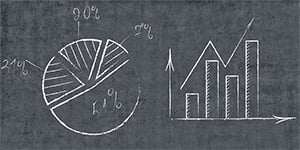Deposit Account Predictions and Strategies for 2015
Will 2015 finally be the year in which the Fed starts to raise interest rates? That’s the big question that savers are asking. If the Fed does begin to raise interest rates, it can still be a long wait for savers before rates rise to levels we saw back in 2006.
With the chance of rate hikes increasing, savers will have to decide if they should hold back on long-term CDs. It can be frustrating to have money in long-term CDs as interest rates rise. However, it can also be frustrating to have money that you don’t currently need in a low-rate savings account as interest rates stay low. That money could be earning much more if it were in a long-term CD. Many savers have probably experienced this problem in the last five years, and it’s possible the same thing could happen this year.
So the first question is will 2015 finally be the year that we see a Fed rate hike? This Calculated Risk blog post reviews this question and offers a prediction:
If the unemployment rate declines to 5.5% or so in the May report, and core inflation continues to move upwards towards 2%, then a June rate hike seems likely.
For a June rate hike to occur, the Fed will very likely be modifying its language in its statements in the next three FOMC meetings. If the language doesn’t change and the words "considerable" and "patient" remain in the statements, the first rate hike will likely be delayed.
Even when the Fed does its first rate hike, there could still be a long period before the Fed increase rates to normal levels. As mentioned in the CR blog post, it’s likely that subsequent rate hikes will be gradual. Rates will likely be close to 1% at the end of 2015.
Since it’s unlikely we’ll see a fast ramp-up in rates, I don’t think it’s wise to give up on long-term CDs. If you keep too much in savings accounts waiting on higher rates, you could lose out on higher interest rates now available in long-term CDs. Many savers have been in this boat for the last few years.
Standard CD Ladder with Mild Early Withdrawal Penalties
If you want to keep things simple, stick with a standard CD ladder. With a standard CD ladder, you don’t have to guess about when rates will rise and how fast they will rise.
If you want to ease worries about being stuck in a long-term CD as rates rise, look for CDs with mild early withdrawal penalties (EWP). I consider a mild EWP to be no more than six months of interest for a 5-year CD. You can compare the effective yields of CDs after the early withdrawal penalties by using our CD early withdrawal penalty calculator. Be aware that there are risks on depending on an early closure of a CD ( see article).
Barbell CD Ladder with Internet Savings Accounts and/or Reward Checking Accounts
If you don’t feel comfortable with long-term CDs as interest rates could be on the verge of increasing, you may want to consider a barbell CD ladder. In this approach about half of the deposit accounts are in long-term CDs and the other half are in online savings accounts and/or reward checking accounts. Short-term CDs are typically used instead of liquid accounts in a barbell CD ladder, but since short-term CD rates are so low, I think internet savings accounts and/or reward checking accounts make more sense.
The more you keep in internet savings accounts and reward checking accounts, the more work will be required. Reward checking accounts offer the best rates, but these require a lot of debit card purchases. And since all have balance caps, you may need multiple reward checking accounts. Even if you find an internet savings account or a reward checking account with a top rate, it doesn’t mean it’ll last. Be prepared to move that money when the bank cuts the rate and/or balance cap. Very few banks remain rate leaders over the long run.
My main concern with having too much money in savings accounts is that it will be hard to know when it’s time to start moving into CDs. As rates start rising, there will always be the question about how much higher they will rise. You may never want to lock into a long-term CD. As we’ve seen in the last six years, that can be costly.
 What Is Bank Fraud? How to Recognize It, Avoid It and Report It
What Is Bank Fraud? How to Recognize It, Avoid It and Report It How to Open a Bank Account for a Minor
How to Open a Bank Account for a Minor How to Balance a Checkbook
How to Balance a Checkbook Retirement Savings: How Much Should I Save Each Month?
Retirement Savings: How Much Should I Save Each Month?

